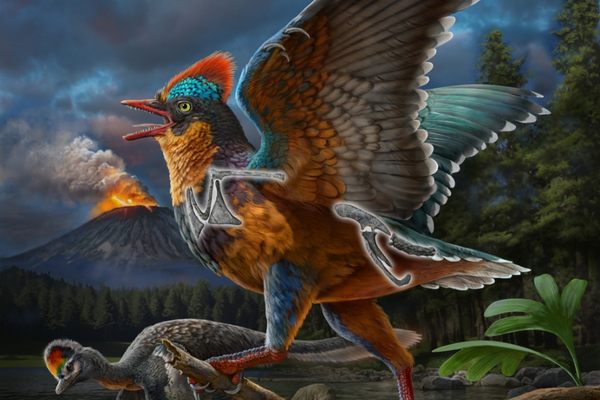One hundred and fifty million years ago, the swamps of Fujian province in southeastern China teemed with life. Fossils reveal a rich Jurassic ecosystem dubbed the Zhenghe Fauna, where turtles, frogs, and fish filled the waters and feathered dinosaurs stalked or waded on long, slender legs. And flitting about in the trees, there was a tiny creature whose recent discovery has upended our understanding of when and how birds became birds.
Its scientific name is Baminornis zhenghensis, a mixture of Mandarin and Ancient Greek meaning “Eight Min bird from Zhenghe” (Eight Min is a historical name for Fujian). Paleontologists discovered its incomplete fossil in 2023 and published a report about it in Nature in February 2025. In a written statement, Wang Min of the Chinese Academy of Sciences, lead researcher on the fossil, described Baminornis as similar in size to “a domesticated pet parrot.” Although Baminornis had small claws on its wings and may have had teeth in its beak, overall, it didn’t look very different from modern birds. That’s exactly what makes it so remarkable.
Just like today’s birds, Baminornis’s spine ended in a fused, stumpy tailbone called a pygostyle. It’s an adaptation for flight that shifts the body’s center of gravity and anchors the tail feathers used for steering in midair. Wang called the development of the pygostyle “one of the most profound changes in body structure during the transition of dinosaurs into birds.” But Baminornis is “the sole Jurassic and the oldest short-tailed bird yet discovered,” Wang wrote, predating previous record-holders like Yixianornis and Confuciusornis by about 20 million years. The discovery offers a new perspective on when birds started to look the way they do now.
In a commentary published in Nature, paleontologist Stephen L. Brusatte wrote that Baminornis “ranks among the most important bird fossils unearthed since the discovery of Archaeopteryx.” In 1861, just two years after Charles Darwin published On the Origin of Species, the first specimen of Archaeopteryx was discovered in Germany, sending shockwaves through the scientific community. Here was a smoking gun for the nascent theory of evolution: An apparent “missing link” between reptile and bird, with feathered, clawed wings, beakless, toothy jaws, and a long, bony tail.
Our knowledge of how birds developed from dinosaurs has come a long way since then. Archaeopteryx is no longer regarded as the direct ancestor of modern birds, but one of many offshoots of the same feathered family tree. However, Archaeopteryx remained the oldest-known bird until the early 2000s, when slightly earlier relatives like Anchiornis were unearthed in China. Prime fossil-forming conditions in some Chinese provinces during the Jurassic and Cretaceous have resulted in hotspots for fossil discoveries, especially feathered dinosaurs. But there are still few birds known from the Jurassic Period (200 to 145 million years ago), and none with a relatively modern appearance—until Baminornis.
Wang argues that Baminornis is modern enough to be the earliest-known species that can be definitively called a bird, rather than a feathered dinosaur. Zhou Zhonghe, another researcher from Wang’s team, said that Baminornis is “the true Jurassic bird,” not Archaeopteryx. Whether you call the bony-tailed species birds or not, we know that they existed alongside Baminornis and for millions of years after. Losing the tail might have made some Jurassic birds better fliers, but it did not give them an immediate survival advantage over tailed birds.
We shouldn’t assume that Baminornis is the direct ancestor of modern birds, as Archaeopteryx was once thought to be, just because of its tailbone. Studies suggest that key characteristics of modern birds, like hollow bones, feathers, and even flight, may have evolved multiple times independently in dinosaurs. Future research might show that the same is true for the fused tailbone.
Evolution does not move in a straight line from point A to point B, and even within the same lineage of animals, vast diversity can exist at the same time. Among the wealth of Jurassic and Cretaceous fossils from China are numerous near-birds and not-birds unlike anything that exists today. Species like Yi qi (Mandarin for “strange wing”) had both feathers and batlike membranous wings, possibly used for gliding rather than true flight. Others had four wings, due to elongated feathers on both sets of limbs. The Enantornithes or “opposite birds” resembled modern birds, but were also strikingly different, with fossil eggs suggesting that at least some species could fly from the moment they hatched.
Baminornis is the latest addition to this dizzying avian menagerie. While you probably wouldn’t think twice if you saw a living Baminornis perched on a telephone wire, the same can’t be said for an Archaeopteryx: Yet the two were contemporaries. The more fossils we discover, the more we see that the story of birds is complex and still far from complete.



